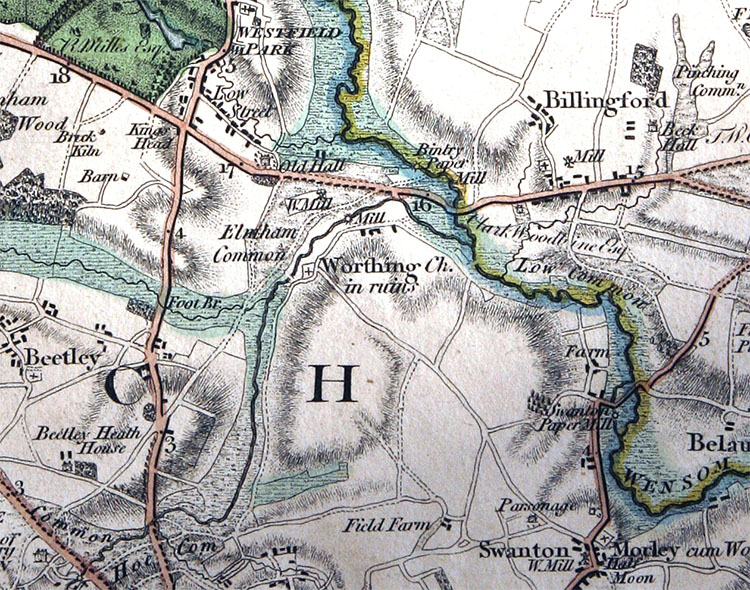Hoe and Worthing Archive: The Village
|
| |
 Faden's map of Norfolk of 1797 shows Worthing, its church 'in ruins', nestled on the north-facing slope of the Wensum valley. To the west the boundary is also formed by water – the stream known variously as the Whitewater, the Blackwater, and the Scarning River. The prominent hill to the south became Swanton Morley airfield in 1940 and remains in military hands, the road running south-east from the church closed since then. [Reproduced by courtesy of Andrew Mcnair.] History of the village
The church is situated on
the side of the valley further upstream, well
separated from the existing village. In the nineteenth
century the road made a detour around the church, but
this has since been straightened. Although there is no
archaeological evidence for occupation between the
village and the church, Thetford ware and medieval
coarse and glazed wares have been collected on the
south side of the latter.
The piece of land adjacent
to the mill was isolated from the common by a small
leet, and this was also private land.
Somewhere near the village
is the line of the Billingford to Denver Roman road.
At present there is a gap in the known line of the
road in Worthing parish. There are no features on the
early nineteenth-century enclosure map which can be
related to the road, which was probably abandoned in
favour of the present valley-side route at an early
stage. It appears that the village was founded only
250 metres away from the line of the Roman road,
although the road itself was probably already disused
by that date.
Roman roads in Norfolk and
the sites of the Roman finds in Worthing.
Extract from Dr O.K.
Schram’s notes: 1209 Wrthing; 1228 Worthing.
 In
the National Archive at the Public Record
Office is the account of a case at the Court
of Chancery held in 1571. The complainant
was a farmer called Thomas Warner (of Hoo)
and the defendants Sir Henry Parker, Lord
Morley, and his steward Robert Constable.
Morley was lord of the manor of Swanton
Morley & Worthing from whom Warner had
leased land in Worthing. A dispute arose
because of unpaid rent. The system of
copyhold leases required the tenant to pay a
‘fine’ to the lord for admission to the
tenancy as well as rent. A copy of the lease
was then given to the tenant. A lease could
be sold to another person who had then to
pay the fine for admission.
Worthing
bridge
  In August 1966 the local newspaper had just about written Worthing off – no girls of 'marriageable age'! The Norfolk Heritage Explorer website lists all the known antiquities in the village: http://www.heritage.norfolk.gov.uk/record-details?TNF276-Parish-Summary-Hoe-%28Parish-Summary%29 |





